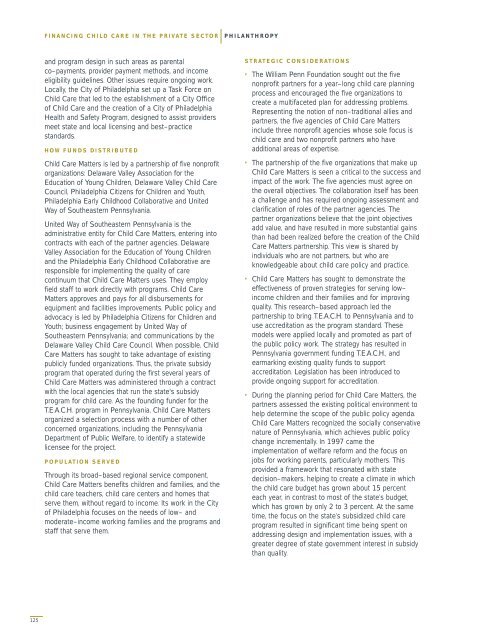Financing Child Care in the United States - Ewing Marion Kauffman ...
Financing Child Care in the United States - Ewing Marion Kauffman ...
Financing Child Care in the United States - Ewing Marion Kauffman ...
You also want an ePaper? Increase the reach of your titles
YUMPU automatically turns print PDFs into web optimized ePapers that Google loves.
FINANCING CHILD CARE IN THE PRIVATE SECTOR PHILANTHROPY<br />
and program design <strong>in</strong> such areas as parental<br />
co–payments, provider payment methods, and <strong>in</strong>come<br />
eligibility guidel<strong>in</strong>es. O<strong>the</strong>r issues require ongo<strong>in</strong>g work.<br />
Locally, <strong>the</strong> City of Philadelphia set up a Task Force on<br />
<strong>Child</strong> <strong>Care</strong> that led to <strong>the</strong> establishment of a City Office<br />
of <strong>Child</strong> <strong>Care</strong> and <strong>the</strong> creation of a City of Philadelphia<br />
Health and Safety Program, designed to assist providers<br />
meet state and local licens<strong>in</strong>g and best–practice<br />
standards.<br />
HOW FUNDS DISTRIBUTED<br />
<strong>Child</strong> <strong>Care</strong> Matters is led by a partnership of five nonprofit<br />
organizations: Delaware Valley Association for <strong>the</strong><br />
Education of Young <strong>Child</strong>ren, Delaware Valley <strong>Child</strong> <strong>Care</strong><br />
Council, Philadelphia Citizens for <strong>Child</strong>ren and Youth,<br />
Philadelphia Early <strong>Child</strong>hood Collaborative and <strong>United</strong><br />
Way of Sou<strong>the</strong>astern Pennsylvania.<br />
<strong>United</strong> Way of Sou<strong>the</strong>astern Pennsylvania is <strong>the</strong><br />
adm<strong>in</strong>istrative entity for <strong>Child</strong> <strong>Care</strong> Matters, enter<strong>in</strong>g <strong>in</strong>to<br />
contracts with each of <strong>the</strong> partner agencies. Delaware<br />
Valley Association for <strong>the</strong> Education of Young <strong>Child</strong>ren<br />
and <strong>the</strong> Philadelphia Early <strong>Child</strong>hood Collaborative are<br />
responsible for implement<strong>in</strong>g <strong>the</strong> quality of care<br />
cont<strong>in</strong>uum that <strong>Child</strong> <strong>Care</strong> Matters uses. They employ<br />
field staff to work directly with programs. <strong>Child</strong> <strong>Care</strong><br />
Matters approves and pays for all disbursements for<br />
equipment and facilities improvements. Public policy and<br />
advocacy is led by Philadelphia Citizens for <strong>Child</strong>ren and<br />
Youth; bus<strong>in</strong>ess engagement by <strong>United</strong> Way of<br />
Sou<strong>the</strong>astern Pennsylvania; and communications by <strong>the</strong><br />
Delaware Valley <strong>Child</strong> <strong>Care</strong> Council. When possible, <strong>Child</strong><br />
<strong>Care</strong> Matters has sought to take advantage of exist<strong>in</strong>g<br />
publicly funded organizations. Thus, <strong>the</strong> private subsidy<br />
program that operated dur<strong>in</strong>g <strong>the</strong> first several years of<br />
<strong>Child</strong> <strong>Care</strong> Matters was adm<strong>in</strong>istered through a contract<br />
with <strong>the</strong> local agencies that run <strong>the</strong> state's subsidy<br />
program for child care. As <strong>the</strong> found<strong>in</strong>g funder for <strong>the</strong><br />
T.E.A.C.H. program <strong>in</strong> Pennsylvania, <strong>Child</strong> <strong>Care</strong> Matters<br />
organized a selection process with a number of o<strong>the</strong>r<br />
concerned organizations, <strong>in</strong>clud<strong>in</strong>g <strong>the</strong> Pennsylvania<br />
Department of Public Welfare, to identify a statewide<br />
licensee for <strong>the</strong> project.<br />
POPULATION SERVED<br />
Through its broad–based regional service component,<br />
<strong>Child</strong> <strong>Care</strong> Matters benefits children and families, and <strong>the</strong><br />
child care teachers, child care centers and homes that<br />
serve <strong>the</strong>m, without regard to <strong>in</strong>come. Its work <strong>in</strong> <strong>the</strong> City<br />
of Philadelphia focuses on <strong>the</strong> needs of low– and<br />
moderate–<strong>in</strong>come work<strong>in</strong>g families and <strong>the</strong> programs and<br />
staff that serve <strong>the</strong>m.<br />
STRATEGIC CONSIDERATIONS<br />
• The William Penn Foundation sought out <strong>the</strong> five<br />
nonprofit partners for a year–long child care plann<strong>in</strong>g<br />
process and encouraged <strong>the</strong> five organizations to<br />
create a multifaceted plan for address<strong>in</strong>g problems.<br />
Represent<strong>in</strong>g <strong>the</strong> notion of non–traditional allies and<br />
partners, <strong>the</strong> five agencies of <strong>Child</strong> <strong>Care</strong> Matters<br />
<strong>in</strong>clude three nonprofit agencies whose sole focus is<br />
child care and two nonprofit partners who have<br />
additional areas of expertise.<br />
• The partnership of <strong>the</strong> five organizations that make up<br />
<strong>Child</strong> <strong>Care</strong> Matters is seen a critical to <strong>the</strong> success and<br />
impact of <strong>the</strong> work. The five agencies must agree on<br />
<strong>the</strong> overall objectives. The collaboration itself has been<br />
a challenge and has required ongo<strong>in</strong>g assessment and<br />
clarification of roles of <strong>the</strong> partner agencies. The<br />
partner organizations believe that <strong>the</strong> jo<strong>in</strong>t objectives<br />
add value, and have resulted <strong>in</strong> more substantial ga<strong>in</strong>s<br />
than had been realized before <strong>the</strong> creation of <strong>the</strong> <strong>Child</strong><br />
<strong>Care</strong> Matters partnership. This view is shared by<br />
<strong>in</strong>dividuals who are not partners, but who are<br />
knowledgeable about child care policy and practice.<br />
• <strong>Child</strong> <strong>Care</strong> Matters has sought to demonstrate <strong>the</strong><br />
effectiveness of proven strategies for serv<strong>in</strong>g low–<br />
<strong>in</strong>come children and <strong>the</strong>ir families and for improv<strong>in</strong>g<br />
quality. This research–based approach led <strong>the</strong><br />
partnership to br<strong>in</strong>g T.E.A.C.H. to Pennsylvania and to<br />
use accreditation as <strong>the</strong> program standard. These<br />
models were applied locally and promoted as part of<br />
<strong>the</strong> public policy work. The strategy has resulted <strong>in</strong><br />
Pennsylvania government fund<strong>in</strong>g T.E.A.C.H., and<br />
earmark<strong>in</strong>g exist<strong>in</strong>g quality funds to support<br />
accreditation. Legislation has been <strong>in</strong>troduced to<br />
provide ongo<strong>in</strong>g support for accreditation.<br />
• Dur<strong>in</strong>g <strong>the</strong> plann<strong>in</strong>g period for <strong>Child</strong> <strong>Care</strong> Matters, <strong>the</strong><br />
partners assessed <strong>the</strong> exist<strong>in</strong>g political environment to<br />
help determ<strong>in</strong>e <strong>the</strong> scope of <strong>the</strong> public policy agenda.<br />
<strong>Child</strong> <strong>Care</strong> Matters recognized <strong>the</strong> socially conservative<br />
nature of Pennsylvania, which achieves public policy<br />
change <strong>in</strong>crementally. In 1997 came <strong>the</strong><br />
implementation of welfare reform and <strong>the</strong> focus on<br />
jobs for work<strong>in</strong>g parents, particularly mo<strong>the</strong>rs. This<br />
provided a framework that resonated with state<br />
decision–makers, help<strong>in</strong>g to create a climate <strong>in</strong> which<br />
<strong>the</strong> child care budget has grown about 15 percent<br />
each year, <strong>in</strong> contrast to most of <strong>the</strong> state’s budget,<br />
which has grown by only 2 to 3 percent. At <strong>the</strong> same<br />
time, <strong>the</strong> focus on <strong>the</strong> state’s subsidized child care<br />
program resulted <strong>in</strong> significant time be<strong>in</strong>g spent on<br />
address<strong>in</strong>g design and implementation issues, with a<br />
greater degree of state government <strong>in</strong>terest <strong>in</strong> subsidy<br />
than quality.<br />
125
















